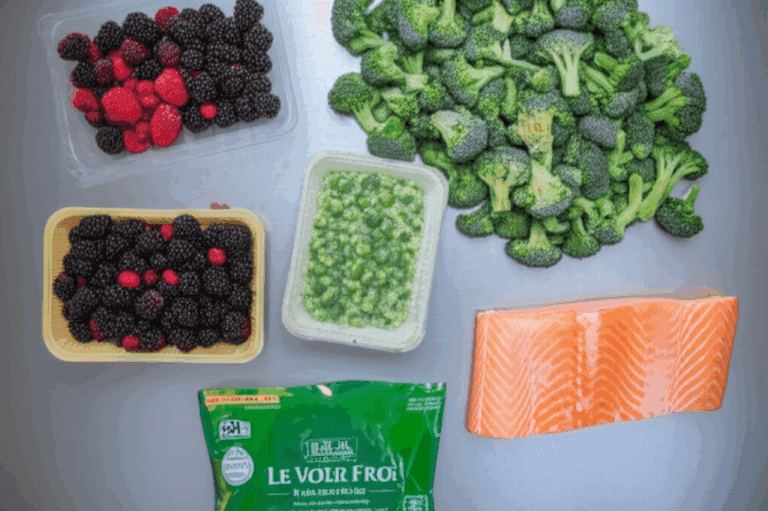For many, the term “frozen food” conjures up images of heavily processed meals, laden with sodium and preservatives. However, the frozen food aisle holds a wealth of nutritious options that, in some cases, can even surpass their fresh counterparts in terms of health benefits. This article will explore five frozen foods that are often healthier than fresh, diving into the science behind why this is the case and offering tips for incorporating these items into your diet.
The Fresh vs. Frozen Debate: A Matter of Time
The perception that fresh food is always superior to frozen stems from the idea that freezing diminishes nutritional value. While it’s true that some nutrients can be lost during the freezing process, the reality is more nuanced. Fresh produce begins to lose nutrients as soon as it’s harvested. The time it takes to transport, store, and finally consume fresh fruits and vegetables can significantly reduce their vitamin and mineral content.
Frozen fruits and vegetables, on the other hand, are typically harvested at peak ripeness and frozen shortly thereafter. This rapid freezing process helps to lock in nutrients, often resulting in a product that is nutritionally comparable to, or even better than, fresh produce that has been sitting on grocery store shelves or in your refrigerator for days.
5 Frozen Foods That Can Be Healthier Than Fresh
Here are five frozen foods where the frozen version often holds a nutritional edge over fresh:
1. Berries
- Why Frozen is Better: Fresh berries, especially those not locally grown, can travel long distances and sit in storage for extended periods. During this time, they can lose significant amounts of Vitamin C and antioxidants. Frozen berries are typically frozen immediately after picking, preserving their nutritional value. Studies have shown that frozen berries can have higher levels of antioxidants than fresh berries that have been stored for several days.
- Health Benefits: Berries are packed with antioxidants, which help protect the body against cell damage. They are also a good source of fiber, vitamins, and minerals.
- How to Incorporate: Add frozen berries to smoothies, oatmeal, yogurt, or use them in baking.
2. Spinach
- Why Frozen is Better: Spinach is a leafy green that is highly susceptible to nutrient loss after harvesting. A study showed that fresh spinach can lose up to 75% of its Vitamin C content within a week of being harvested, even when refrigerated. Frozen spinach, blanched before freezing, retains more of its nutrients.
- Health Benefits: Spinach is rich in vitamins A, C, and K, as well as iron and antioxidants.
- How to Incorporate: Use frozen spinach in soups, stews, pasta dishes, or sauté it as a side dish.
3. Broccoli
- Why Frozen is Better: Like spinach, broccoli can lose nutrients quickly after being harvested. Freezing helps to preserve its vitamins and minerals. Studies have shown that frozen broccoli can have similar levels of Vitamin C and other nutrients compared to fresh broccoli.
- Health Benefits: Broccoli is an excellent source of vitamins C and K, as well as fiber and antioxidants. It also contains compounds that may help protect against cancer.
- How to Incorporate: Steam or roast frozen broccoli as a side dish, add it to stir-fries, or use it in casseroles.
4. Peas
- Why Frozen is Better: Peas are another vegetable that benefits from being frozen shortly after harvesting. Fresh peas can quickly become starchy and lose their sweetness and nutritional value. Frozen peas retain their sweetness and nutrients.
- Health Benefits: Peas are a good source of fiber, vitamins A, C, and K, and minerals.
- How to Incorporate: Add frozen peas to soups, stews, pasta dishes, or serve them as a simple side dish.
5. Seafood (Shrimp, Salmon, and certain Fish fillets)
- Why Frozen is Better: Fresh seafood can be difficult to source and can spoil quickly. Unless you live near the coast and have access to freshly caught fish, frozen seafood is often a better option. Freezing preserves the quality and freshness of the fish, and it can be just as nutritious as fresh. Look for individually vacuum-packed portions that are frozen solid with no ice crystals.
- Health Benefits: Seafood is a great source of lean protein, omega-3 fatty acids, and other essential nutrients.
- How to Incorporate: Thaw frozen seafood and grill, bake, or pan-fry it. Add it to pasta dishes, salads, or tacos.
The Blanching Process: What You Need to Know
Many vegetables are blanched before freezing. Blanching involves briefly immersing vegetables in boiling water or steam, then quickly cooling them in ice water. This process helps to stop enzyme activity that can degrade the quality, color, and flavor of the vegetables during freezing.
While blanching can cause some nutrient loss, particularly of water-soluble vitamins like Vitamin C and B vitamins, the overall nutritional benefits of freezing often outweigh these losses. Furthermore, not all vegetables are blanched before freezing, and fruits are typically not blanched at all.
Tips for Choosing and Using Frozen Foods
To maximize the health benefits of frozen foods, keep these tips in mind:
- Read Labels Carefully: Check the ingredient list for added salt, sugar, or unhealthy fats. Choose products with minimal ingredients.
- Look for “Flash Frozen”: This indicates that the food was frozen quickly, which helps to preserve its quality and nutrients.
- Store Properly: Keep frozen foods at a consistent temperature of 0°F (-18°C) or lower to prevent freezer burn and maintain quality.
- Don’t Refreeze: Once a frozen food has thawed, do not refreeze it, as this can increase the risk of bacterial growth.
- Cook Appropriately: Follow cooking instructions carefully to ensure that the food is cooked thoroughly and safely.
Beyond the Basics: Expanding Your Frozen Food Horizons
While the five foods listed above are excellent choices, don’t limit yourself. The frozen food aisle offers a variety of healthy options, including:
- Fruits: Mangoes, pineapples, cherries, and other fruits can be just as nutritious when frozen.
- Vegetables: Corn, green beans, carrots, and mixed vegetables are all convenient and healthy choices.
- Grains: Frozen cooked quinoa, brown rice, and other grains can save time and effort in the kitchen.
- Lean Proteins: Frozen chicken breasts, turkey burgers, and other lean proteins are great for quick and easy meals.
Debunking Common Myths About Frozen Food
- Myth: Frozen food is less nutritious than fresh food.
- Reality: As discussed, frozen food can often be more nutritious than fresh food that has been stored for several days.
- Myth: Frozen food is full of preservatives.
- Reality: Many frozen foods do not contain added preservatives. Freezing itself is a natural method of preservation.
- Myth: Frozen food is expensive.
- Reality: Frozen food can often be more affordable than fresh, especially when buying out-of-season produce.
- Myth: Frozen food is only for convenience meals.
- Reality: Frozen food can be used in a variety of healthy and delicious recipes.
Making Informed Choices for a Healthier Diet
Ultimately, the key to a healthy diet is to eat a variety of nutrient-rich foods, whether they are fresh, frozen, or canned. By understanding the benefits of frozen foods and making informed choices, you can easily incorporate these items into your diet and enjoy their convenience, affordability, and nutritional value. Don’t let the misconception that “fresh is always best” limit your options. Embrace the frozen food aisle and discover the many healthy and delicious possibilities it has to offer.
By choosing wisely, you can ensure that you’re getting the nutrients you need, regardless of whether you opt for fresh or frozen options. So, next time you’re at the grocery store, don’t overlook the frozen food aisle – you might be surprised at what you find.







